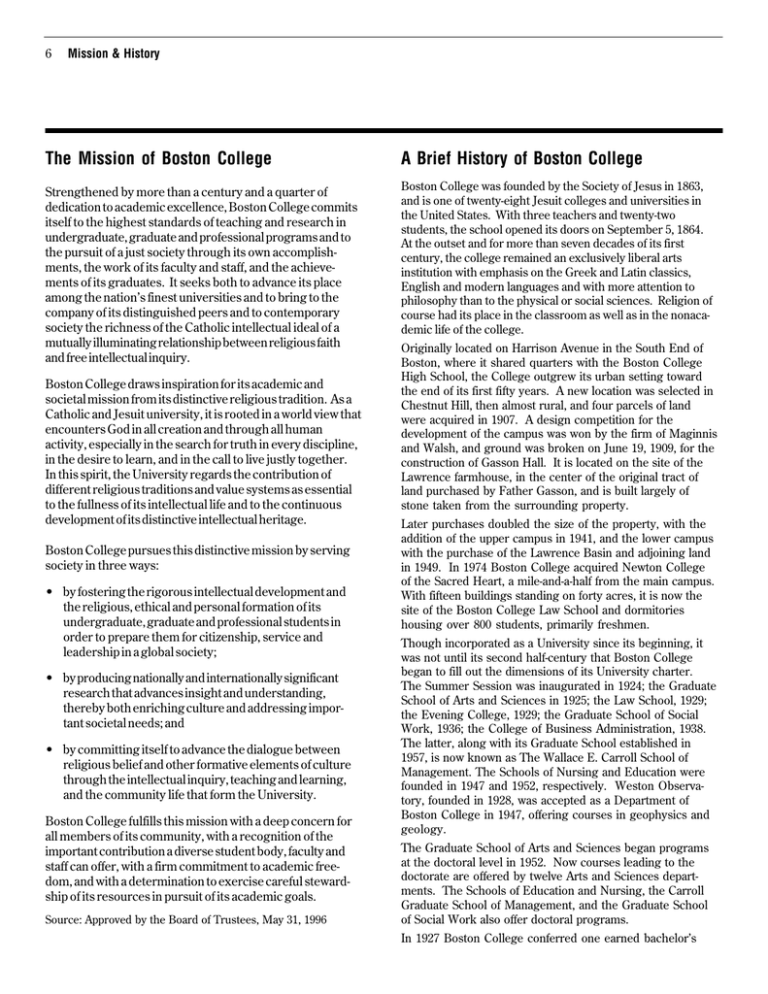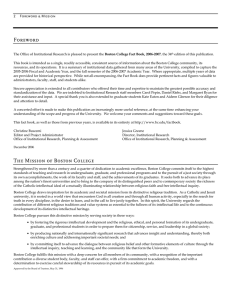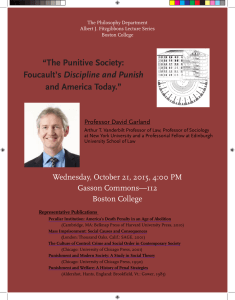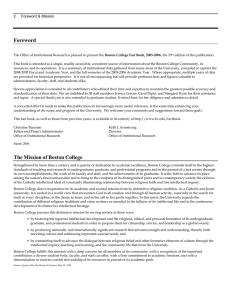A Brief History of Boston College The Mission of Boston College 6
advertisement

6 Mission & History The Mission of Boston College A Brief History of Boston College Strengthened by more than a century and a quarter of dedication to academic excellence, Boston College commits itself to the highest standards of teaching and research in undergraduate, graduate and professional programs and to the pursuit of a just society through its own accomplishments, the work of its faculty and staff, and the achievements of its graduates. It seeks both to advance its place among the nation’s finest universities and to bring to the company of its distinguished peers and to contemporary society the richness of the Catholic intellectual ideal of a mutually illuminating relationship between religious faith and free intellectual inquiry. Boston College was founded by the Society of Jesus in 1863, and is one of twenty-eight Jesuit colleges and universities in the United States. With three teachers and twenty-two students, the school opened its doors on September 5, 1864. At the outset and for more than seven decades of its first century, the college remained an exclusively liberal arts institution with emphasis on the Greek and Latin classics, English and modern languages and with more attention to philosophy than to the physical or social sciences. Religion of course had its place in the classroom as well as in the nonacademic life of the college. Boston College draws inspiration for its academic and societal mission from its distinctive religious tradition. As a Catholic and Jesuit university, it is rooted in a world view that encounters God in all creation and through all human activity, especially in the search for truth in every discipline, in the desire to learn, and in the call to live justly together. In this spirit, the University regards the contribution of different religious traditions and value systems as essential to the fullness of its intellectual life and to the continuous development of its distinctive intellectual heritage. Boston College pursues this distinctive mission by serving society in three ways: • by fostering the rigorous intellectual development and the religious, ethical and personal formation of its undergraduate, graduate and professional students in order to prepare them for citizenship, service and leadership in a global society; • by producing nationally and internationally significant research that advances insight and understanding, thereby both enriching culture and addressing important societal needs; and • by committing itself to advance the dialogue between religious belief and other formative elements of culture through the intellectual inquiry, teaching and learning, and the community life that form the University. Boston College fulfills this mission with a deep concern for all members of its community, with a recognition of the important contribution a diverse student body, faculty and staff can offer, with a firm commitment to academic freedom, and with a determination to exercise careful stewardship of its resources in pursuit of its academic goals. Source: Approved by the Board of Trustees, May 31, 1996 Originally located on Harrison Avenue in the South End of Boston, where it shared quarters with the Boston College High School, the College outgrew its urban setting toward the end of its first fifty years. A new location was selected in Chestnut Hill, then almost rural, and four parcels of land were acquired in 1907. A design competition for the development of the campus was won by the firm of Maginnis and Walsh, and ground was broken on June 19, 1909, for the construction of Gasson Hall. It is located on the site of the Lawrence farmhouse, in the center of the original tract of land purchased by Father Gasson, and is built largely of stone taken from the surrounding property. Later purchases doubled the size of the property, with the addition of the upper campus in 1941, and the lower campus with the purchase of the Lawrence Basin and adjoining land in 1949. In 1974 Boston College acquired Newton College of the Sacred Heart, a mile-and-a-half from the main campus. With fifteen buildings standing on forty acres, it is now the site of the Boston College Law School and dormitories housing over 800 students, primarily freshmen. Though incorporated as a University since its beginning, it was not until its second half-century that Boston College began to fill out the dimensions of its University charter. The Summer Session was inaugurated in 1924; the Graduate School of Arts and Sciences in 1925; the Law School, 1929; the Evening College, 1929; the Graduate School of Social Work, 1936; the College of Business Administration, 1938. The latter, along with its Graduate School established in 1957, is now known as The Wallace E. Carroll School of Management. The Schools of Nursing and Education were founded in 1947 and 1952, respectively. Weston Observatory, founded in 1928, was accepted as a Department of Boston College in 1947, offering courses in geophysics and geology. The Graduate School of Arts and Sciences began programs at the doctoral level in 1952. Now courses leading to the doctorate are offered by twelve Arts and Sciences departments. The Schools of Education and Nursing, the Carroll Graduate School of Management, and the Graduate School of Social Work also offer doctoral programs. In 1927 Boston College conferred one earned bachelor’s





